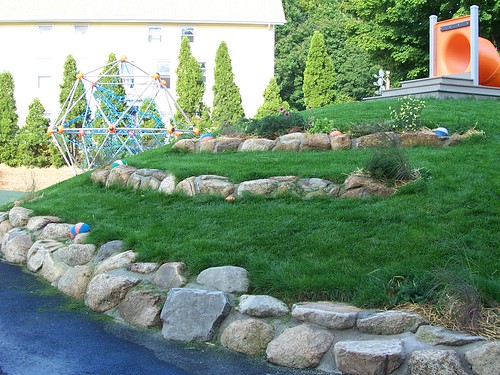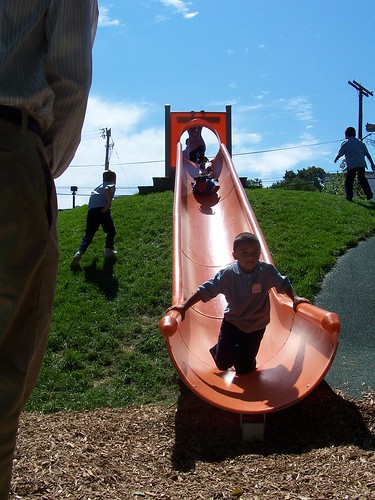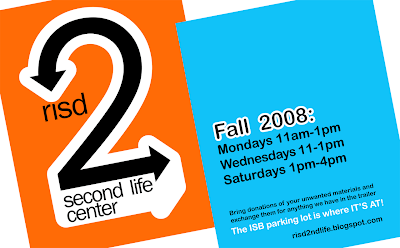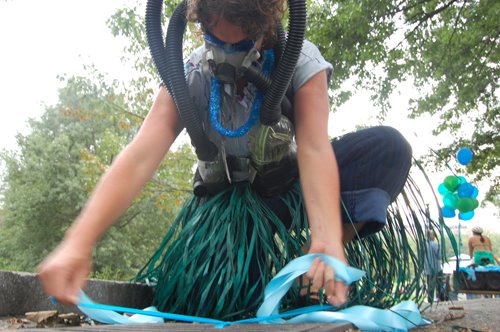This month marks the beginning of a new collaboration between RISD, the Learning Community Charter School, and New Urban Arts.
September 26th saw the official opening of the Learning Community’s new play space (you can read more about that
here,), after months and months of conversations and committee meetings between students, staff, and parents of TLC. The school selected Laurencia Strauss, a recent RISD graduate from Landscape Architecture department, to synthesize this mass of information into a cohesive design.

Upon receiving an invitation to the opening, I had gotten the idea in my head to make a short experiential video of the kids’ movements and play, but rain and chaos deterred the initial plan. Instead, at the opening I entered into a conversation with Laurencia and Kath Connelly, the school’s Communications and Outreach Coordinator, about how to share the missing pieces of the story of this collaboration to the larger audience of RISD and beyond.
While much has been made of the entrepreneurial spirit of the six fourth-graders who formed the Playground Committee and were responsible for the letter to the CEO of Loews, which resulted in a $110,000 grant, we wanted to highlight the elements of the collaborative process and Laurencia’s own artistic vision which moved the project from seed to completion. The question became how to expand on the idea of a more traditional reporting piece to a video that captures the dynamic learning experience that underwrote this entire project.
To get started, Kath invited Andrew Oesch, one of the New Urban Arts artist mentor fellows, and I to spend an afternoon perched in the second floor stairwell of the Learning Community observing how the different classes were using the new playground. While it felt strangely big-brotheresque whenever a kid would glance up and catch us staring back from the second floor window, this perspective allowed us to witness the overall flow of movement around the playground while still being close enough to catch the nuances of individual group dynamics.
What did we see? Fifth graders, followed by the kindergarteners, explode out onto the playground, most racing straight up the hill. Some made a beeline for the sandbox, and still others just ran a few laps before settling into a game of dodge ball, basketball, or just plain “kick the ball!”
There was a constant shifting of energy – at one point the entire playground clustered en masse in the matter of seconds (was someone hurt? was it a big bug?), only to disperse as quickly once they’d diagnosed the situation. There were also diverse ways in which different age groups used the same spaces. For instance, the kindergarteners piled and sorted leaves on top of the wood stump tables on the stage (girls at one “table” and boys at the other), while the older students used that space for one-on-one conversations (also gender-divided). Older kids had figured out that their jackets made great surfboards for going down the slide faster – kneeling, standing, face-first – while the younger groups proceeded in more orderly fashion.

There really isn’t enough time to go into all of the amazing things we watched transpire, but needless to say Andrew and I were wide-eyed and captivated by the sheer amount of human energy being exerted in a relatively small amount of space!
When Kath joined us, we served as a kind of sounding board for many of the reflections she’s been processing over the last year of this project. As the person who worked most closely with Laurencia, she was particularly attuned to the finer subtleties of the dynamics that played out over the year long collaborative process.
Some of the points she brought up will be great to develop further during the video interviews. These include: the pedagogical overlap with the built environment, the importance of setting up basic parameters in the built environment while also letting go of how the space gets used (both for the designer and the school,) unintended uses of the playground and how the neighborhood has embraced the space as a community park, how Laurencia took abstract concepts that came from the kids and staff and created spaces and objects flexible enough to handle multiple uses, etc.
Kath also introduced us to Ms. Kathy, the third grade teacher whose classroom overlooks the playground. At the beginning of the year, Ms. Kathy quickly recognized that the students’ attention was being drawn to the giant colorful space outside their windows. Her ingenious response was to build into the curriculum a journaling project in which the students wrote about and then investigated their continued wonderings about the new playground. How to employ this new space as a kind of learning lab is one of the exciting new arenas the school will be exploring over the course of the next several months.
The next day, I met up with Laurencia, which helped to build upon the conversations that I’d been having with Andrew, Kath, and Ms. Kathy. There is a shared sense that this video piece can be a way for Laurencia to engage in her own reflection about the process of building the play space. She had been so involved in the day-to-day logistics that only now is she beginning to articulate what actually happened.
Specifically we spoke at length about what makes an artist well suited to collaborative or community-engaged art practices and that delicate dance between personal vision and incorporating multiple perspectives and desires. This led to an interesting conversation about how universities can best support the students on campus who are drawn to a collaborative mode of art making. Which also raises the contrary question of whether a school environment is the most appropriate place to explore/introduce community-based projects at all.
Given the artificial timeframe of semesters and the focus on individual creative vision and a strong commitment to studio practice, is it possible to realize collaborative projects where on-going relationship-building and deep listening are prerequisites to the project’s success?
This I believe is one of the many challenges in building and sustaining university-community relationships in collaborative projects. For this specific project, Kath’s role as mediator will prove to be invaluable. Through her clear articulation of how the school emboldens students to build literary and communication fluency, we are better able to create a platform for new learning opportunities by all parties.






















